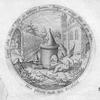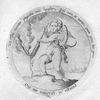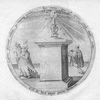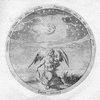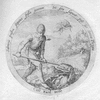Qui me nourrist, m’estaind [5]
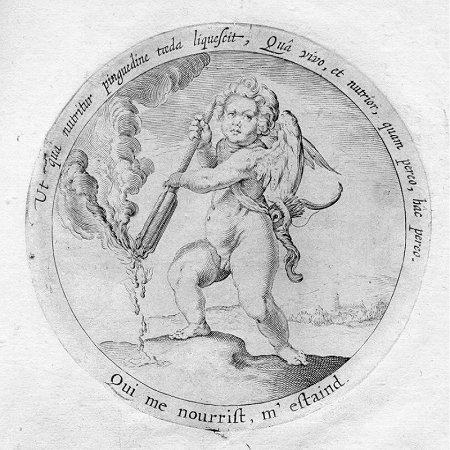
Het ghene dat de torts ontsteeckt en doetse branden/
Dat selve blust se weer als m’ommekeert1 zijn handen.
Zoo gaet het met de min/ O wreeden brandt/ O brandt/
Wat baet mijn wijsheydt my/ oft’ treffelick verstandt?
Ick gae her ende we’er2/ ick gae nu zoo veel daghen/
En soeck dees en die/ om mijnen noodt te claghen.
Ick moet weer na het vier// de ghene die ’t my doet
Als oorsaeck van mijn vier/ mijn vier oock blussen moet.
Dat selve blust se weer als m’ommekeert1 zijn handen.
Zoo gaet het met de min/ O wreeden brandt/ O brandt/
Wat baet mijn wijsheydt my/ oft’ treffelick verstandt?
Ick gae her ende we’er2/ ick gae nu zoo veel daghen/
En soeck dees en die/ om mijnen noodt te claghen.
Ick moet weer na het vier// de ghene die ’t my doet
Als oorsaeck van mijn vier/ mijn vier oock blussen moet.

Translations
 |
Wie me voedt, dooft me ook. |
 |
Who feeds me extinguishes me. |
 |
Zoals een fakkel door het vet waarmee hij gevoed wordt, ook weer dooft, zo kom ik om door wie ik leef en wordt gevoed en door degene op wie ik smoorverliefd ben. |
 |
As a torch is extinguished by the fat that feeds it, thus who gives me life, feeds me and infatuates me engenders my death. |
Literature
-
Henkel and Schöne, Emblemata
 , col. 1365
, col. 1365
-
Praz, Seventeenth-Century Imagery
 , p. 92
, p. 92
Sources and parallels
- Same emblem in 1601 edition: Qui me nourrist, m’estaind [5] (in: Daniël Heinsius, Quaeris quid sit Amor (c. 1601))
[Compare
![Compare [compare]](/static/images/compare2.gif) ]
]
- A source for the pictura and the entire emblem: Paradin, Princeliicke Deviisen
 , embl. 208
, embl. 208
- A source for the pictura and the entire emblem: Giovio, Dialogo dell'imprese
 , pp. 200-201
, pp. 200-201
- A source for the pictura: Junius, Emblemata [web]
 , embl. 54
, embl. 54 - Junius uses the image of a torch turned upside down also in the preceding
emblem: Junius, Emblemata [web]
 , embl. 53
, embl. 53 - The motto and main pictorial element can also be found in: De Montenay, Emblèmes
 , embl. 54
, embl. 54 - A parallel (and probably adaptation) for the entire emblem (motto,
pictura and latin subscriptio): Quod nutrit, extinguit [96] (in: Otto Vaenius, Amorum emblemata (1608))
[Compare
![Compare [compare]](/static/images/compare2.gif) ]
]
-
Parallel in the 1616 edition: motto and subscriptio are the same; pictura is mirrored and more detailed in the background:
Qui me nourrist, m'estaind. [29] (in: Daniël Heinsius, Ambacht van Cupido, from: Nederduytsche poemata (1616))
[Compare
![Compare [compare]](/static/images/compare2.gif) ]
]
-
A parallel (and probably adaptation) for the pictura: Amor, tela penelopes. [44] (in: Jacob Cats, Sinne- en minnebeelden (1627))
[Compare
![Compare [compare]](/static/images/compare2.gif) ]
]
-
Porteman 1975, p. 213. Pictura substantially altered in:Invincibilitas Amoris [70] (in: Ludovicus van Leuven, Amoris divini et humani antipathia (1629))
[Compare
![Compare [compare]](/static/images/compare2.gif) ]
]
References, across this site, to this page:
- Amor, tela penelopes. [44] (in: Jacob Cats, Sinne- en minnebeelden (1627))
- Qui me nourrist, m’estaind [5] (in: Daniël Heinsius, Quaeris quid sit Amor (c. 1601))
- Qui me nourrist, m'estaind. [29] (in: Daniël Heinsius, Ambacht van Cupido (1613))
- Qui me nourrist, m'estaind. [29] (in: Daniël Heinsius, Ambacht van Cupido, from: Nederduytsche poemata (1616))
- Quod nutrit, extinguit [96] (in: Otto Vaenius, Amorum emblemata (1608))
Iconclass
Cupid extinguishing a burning torch by holding it upside down- fire (one of the four elements)
[21C]

- landscapes in the temperate zone
[25H1]

- torch - BB - torch held upside down (+ extinguishing; extinguished light, lamp, candle)
[41BB32(+2)]

- archer's weapons: arrow
[45C15(ARROW)]

- archer's weapons: bow
[45C15(BOW)]

- (personifications and symbolic representations of) Love; 'Amore (secondo Seneca)' (Ripa) (+ emblematical representation of
concept)
[56F2(+4)]

- Vitality, Viability, Vital Force (+ emblematical representation of concept)
[58B1(+4)]

- Mortality, Extinction of Life (+ emblematical representation of concept)
[58BB1(+4)]

- proverbs, sayings, etc. (with TEXT)
[86(QUI ME NOURRIST, M'ESTAIND)]

- other non-aggressive activities of Cupid
[92D156]

- attributes of Cupid (with NAME)
[92D18(BOW)]

- attributes of Cupid (with NAME)
[92D18(QUIVER)]

![[H O M E : Emblem Project Utrecht]](/static/images/rd-small.gif)




